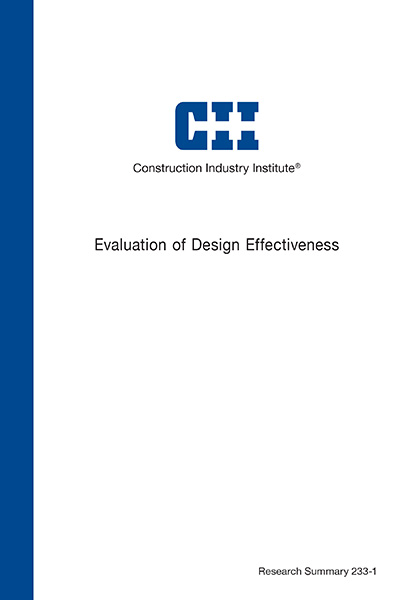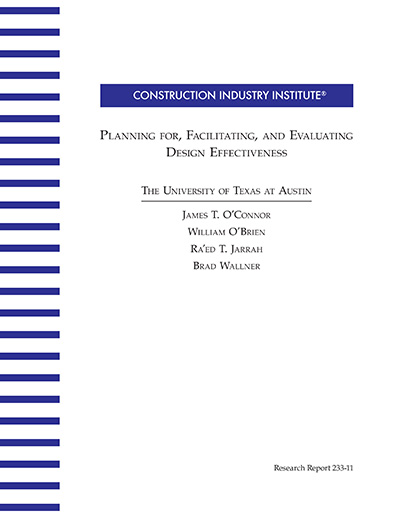
Evaluation of Design Effectiveness
Design effectiveness is the degree to which the project design effort contributes to achieving targeted project value objectives. Simply put, effective design enhances project value, and to achieve project goals, design must be effective.
While the 1986 CII objectives matrix for design effectiveness is still valid (see Evaluation of Design Effectiveness, CII Research Summary 8-1), that publication now appears narrow in scope and does not reflect many factors that enhance design effectiveness. These factors include front end planning, planning for startup, engineering productivity metrics, value management processes, facility security, sustainability, and project performance benchmarking, among others. In today’s environment, a completed project that performs well with regard to some project objectives while missing the mark on others is seldom considered a success.
CII formed the Design Effectiveness (DE) Research Team, RT133, not only to update the DE evaluation methodology and criteria, but also to emphasize the importance of proactive planning for design effectiveness and to identify and characterize supportive tools and processes. Accomplishing this objective, this publication presents a process and a tool for evaluating design effectiveness for projects of varying size and scope across all industry sectors.
The DE evaluation process involves the vital step of measurement; reliable measurement provides the data needed to assess the effectiveness of design relative to project value objectives (PVO). In turn, this assessment helps provide feedback to design teams and project leaders, and, if needed, can lead to constructive adjustments to design efforts.
A project team may wish to use evaluation criteria based on project value objectives as a way to gain alignment on more specific performance oriented design objectives. Alternatively, interim DE assessments may be desired during the design effort and prior to design completion in order to provide an opportunity to affect mid-course corrections. Long-term performance benchmarking and application of incentives provide two more reasons for pursuing formal design effectiveness. Thus it is clear that Design Effectiveness may be evaluated from the perspective of the owner, the designer, the construction team, or any combination of these parties. (RS233-1, p. 6)
The evaluation of design effectiveness is driven by 4 different motives:
- Stakeholder alignment on design objectives
- Continuous improvement
- Metric for benchmarking
- Basis for incentives
This model is developed to provide guidance to organizations on how to set up and administer a MEV/DE program within both a company and a project team. The model promotes efficient MEV/DE strategies and tools for both project and organization wide continuous improvement efforts. Design effectiveness is a collection of subcomponents within the larger MEV/DE process. Key components/steps of DE within this model include: (RS233-1, p. 7)
- Prioritize project value objectives and DE objectives
- Plan for DE evaluation
- Evaluate DE performance
- Make use of DE evaluation
- Identify strategy implementation lessons
- Ensure impact of MEV/DE efforts
The DE evaluation approach is driven by these 11 Project Value Objectives (PVO). Thirty effective design practices are identified in support of these 11 PVOs. (RS233-1, p. 11)
- Security
- Operations and Maintenance Safety
- Construction Safety
- Regulatory and Standards Compliance
- Capital Cost Reduction
- Operations and Maintenance Efficiency
- Product/Plant/Service Quality
- Design and Construction Quality
- Schedule Reduction
- Environmental Stewardship
- Flexibility for Future Use
Multiple, optional sub-criteria under each PVO category constitute the detailed attributes by which design performance is evaluated. The sub criteria are specific characteristics that together with measurement scales constitute the DE evaluation tool.


